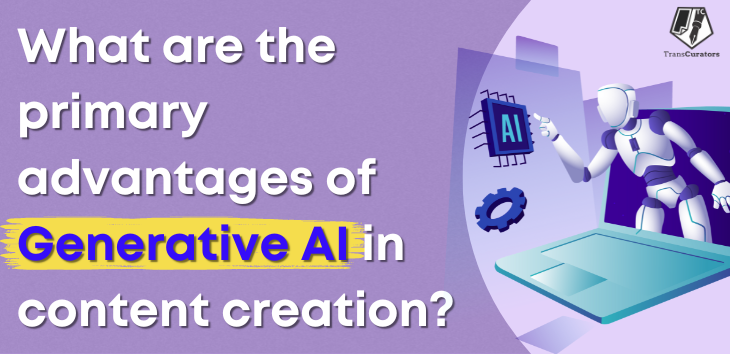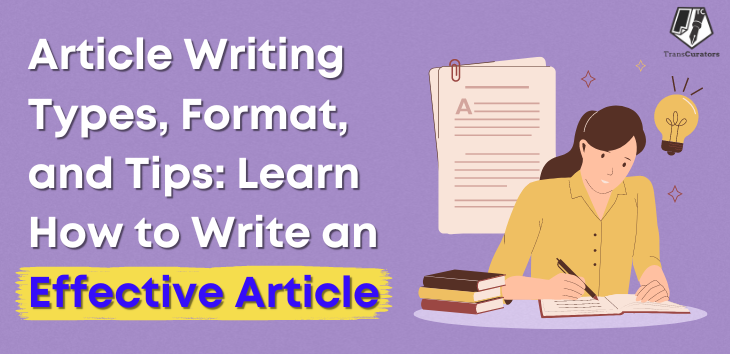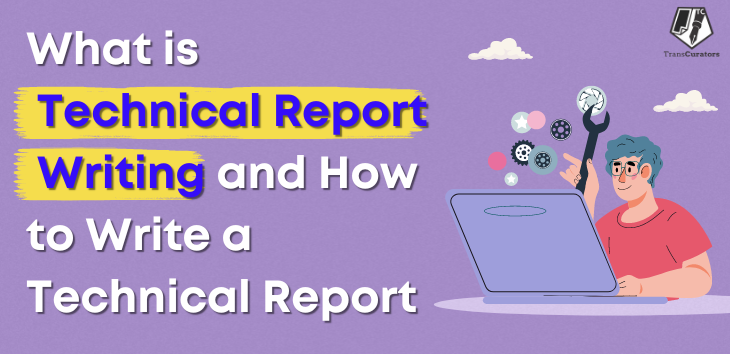
In today’s digital age, content creation is at the core of various industries, including marketing, entertainment, education, and more. As the demand for high-quality content grows, the need for efficient and innovative tools becomes more pressing. This is where generative AI offers significant advantages transforming how we produce and manage content. The primary advantage of generative AI in content creation is its capacity to enhance creativity and productivity, simplify workflows, and deliver tailored experiences on a massive scale. Let’s dive in and study this topic in detail.
Understanding Generative AI
Generative AI refers to systems that can produce fresh content based on the data on which they have been trained. Unlike traditional AI, which is often limited to data analysis and prediction, generative AI can generate something new. This capability is based on advanced algorithms and neural networks, intensive learning models such as Generative Adversarial Networks (GANs), and transformers.
What is AI Content Creation
AI content creation entails using artificial intelligence to create written or visual content. This technology creates articles, social media posts, product descriptions, images, videos, and more. AI algorithms learn from existing information, identify patterns, and generate new content that resembles human work. These tools combine natural language processing (NLP) and machine learning to grasp context, structure, and style, producing coherent and relevant content.
Why Use AI for Content Creation
1. Efficiency and Speed:
AI creates content far more quickly than humans. To meet digital marketing needs, businesses often need vast volumes of content to be provided promptly. AI tools can create excellent articles, blog posts, and social media updates in a fraction of the time it usually takes a human writer. This effectiveness enables businesses to stay current and constantly engage their target audience.
2. Cost-Effectiveness:
Hiring expert writers, designers, and video editors can get pricey. AI content creation tools provide a more affordable option. Once set up, they offer a consistent stream of content without incurring the ongoing costs that come with human labour.
3. Scalability:
AI allows businesses to scale their content production quickly. AI can manage greater demand without affecting quality, whether you need to grow your blog, populate an e-commerce site with product descriptions, or run a busy social media schedule. This scalability is critical for expanding organisations aiming to improve their online presence.
4. Consistency:
Having a consistent voice and style across all content can be challenging, mainly when several writers are contributing. AI tools maintain uniformity by adhering to preset guidelines and templates. This consistency strengthens the brand’s identity and makes the content more recognizable and credible.
5. Personalization:
AI uses user data analysis to provide content customised to each user’s tastes and behaviours. Marketing messaging, product suggestions, and email campaigns tailored to specific audience segments are more successful. Customization enhances customer experience and increases user engagement.
6. Creative Assistance:
AI can help writers and designers overcome creative obstructions by providing new concepts, generating initial drafts, and suggesting changes. Content created by humans and AI together is more innovative and well-produced.
AI content creation has various advantages, including efficiency, cost-effectiveness, scalability, consistency, personalization, and creative assistance. Businesses can use AI to create excellent content that engages their audience, promotes their brand, and accelerates growth. Balancing AI skills with human expertise guarantees the most significant outcome for content creation.
Types of Content You Can Create with AI
Artificial intelligence (AI) has transformed the landscape of content creation, opening up opportunities for creating diverse and captivating content. AI tools help to create multiple types of content, enhancing creativity, efficiency, and personalisation. Let’s explore the different types of content that can be created with AI.
1. Text Content
- Articles and Blog Posts: AI can create articles and blog posts on various topics. By analysing keywords and existing content, AI tools generate informative and relevant posts that meet SEO standards.
- Product Descriptions: For e-commerce websites, AI helps generate product descriptions quickly and accurately. These descriptions highlight key features, benefits, and specifications, enhancing the shopping experience.
- Social Media Posts: AI creates engaging social media content customised to specific platforms and audiences. This includes creating posts, tweets, and captions that capture attention and foster interaction.
- Emails and Newsletters: AI assists in creating personalised emails and newsletters that connect with recipients. AI tools can generate targeted messages based on user data, increasing open rates and engagement.
2. Visual Content
- Images: AI algorithms produce graphics based on textual descriptions, allowing the creation of personalised visuals for marketing campaigns, blog posts, and social media.
- Infographics: Artificial intelligence tools create visually appealing infographics that understandably transmit complicated information. These infographics contribute to the effective communication of data and statistics.
- Videos: AI assists in video creation by producing scripts, editing footage, and even creating animations. This simplifies video production and enables businesses to create professional-looking videos quickly and effectively.
- Logos and Graphics: AI can design logos, banners, and other graphics for branding purposes. They also offer customization options, allowing businesses to produce visuals that align with their brand identity.
3. Audio Content
- Voiceovers: AI creates natural-sounding voiceovers for videos, presentations, and other multimedia content. This improves the audiovisual experience and gives a professional touch to content production.
- Podcasts: AI helps in podcast production by generating scripts and suggesting topics. This streamlines the podcast-producing process and provides a consistent standard across episodes.
- Music: AI algorithms can compose music tracks for a variety of purposes, including background music and full compositions. Musicians and content creators use AI to experiment with new musical concepts and genres, enhancing creativity and innovation.
4. Interactive Content
- Chatbots: AI-powered chatbots offer immediate support to website visitors and customers. They can respond to questions, provide recommendations, and walk consumers through various processes, enhancing the user experience and engagement.
- Quizzes and Surveys: AI facilitates the creation of interactive quizzes and surveys that engage users and collect valuable feedback. These interactive elements boost user engagement and give helpful insights into business choices.
- Virtual Assistants: AI develops virtual assistants that communicate with users via voice or text. These assistants can do activities, answer questions, and deliver information, consequently improving user experience and productivity.
5. Data-Driven Content
- Reports and Analytics: AI creates reports and insights via data analysis. These insights help businesses to make more informed choices, optimise strategy, and drive growth.
- Personalised Recommendations: AI analyses user behaviour and preferences to make customised content recommendations. This improves the user experience by providing relevant information based on individual interests and preferences.
- Dynamic Web Content: AI serves to develop dynamic online content that adapts to user interactions. This includes personalised landing pages, content suggestions, and tailored advertisements depending on user preferences, which boosts engagement and conversions.
Benefits of Using AI for Content Creation
Artificial intelligence has transformed the way we generate content. From writing articles to generating photos, AI tools have made content creation faster, more efficient, and frequently more interesting. Let’s explore the numerous benefits of using AI for content creation.
1. Increased Efficiency and Speed
AI can generate content much faster than humans. When you need to create huge quantities of content quickly, AI can manage the workload. For example, AI can produce blog posts, social media updates, and product descriptions in minutes. This speed enables organisations to keep up with the fast-paced demands of digital marketing while maintaining a consistent flow of content.
2. Cost-Effective Solution
Hiring highly skilled writers, designers, and videographers can be expensive. AI provides a cost-effective solution by automating most of the content creation process. Once set up, AI tools can create content without paying the continuous expenses associated with human labour. This makes AI an important resource for startups and small businesses that have limited budgets.
3. Consistency in Quality and Style
Maintaining a consistent voice and style throughout all content can be challenging, particularly when multiple creators are involved. AI promotes uniformity by following set norms and patterns. Whether you want blog posts, social media content, or product descriptions, AI tools can replicate the correct tone and style, consequently reinforcing your brand identity.
4. Scalability
As your business expands, so will the need for content. AI enables you to grow your content production seamlessly. Whether you need to extend your blog, upgrade your website, or increase your social media presence, AI can manage the extra work without compromising quality. This scalability is critical for businesses trying to grow their online presence and attract a larger audience.
5. Personalization and Engagement
AI can analyse user data and provide personalised content based on individual preferences and behaviours. For example, AI can create customised email campaigns, product suggestions, and marketing messaging that are more effective with different audience segments. Personalization boosts user engagement, customer experience, and the likelihood of conversion.
6. Enhanced Creativity and Innovation
While artificial intelligence (AI) cannot replace human creativity, it can significantly improve it. AI tools can generate new ideas, prompt drafts, and suggestions for improvements, assisting authors and designers in overcoming creative challenges. This collaboration between humans and AI generates more imaginative and polished content. For example, AI can create fresh graphic designs for marketing campaigns or recommend new blog post topics.
7. Data-Driven Insights
AI can filter over massive volumes of data to identify trends, topics, and phrases that are likely to appeal to your intended audience. This data-driven strategy guarantees that the content you create is relevant and search-engine-optimised, which increases visibility and interaction. Understanding your audience’s interests allows you to customise your content strategy so it can better match their needs.
8. Time-Saving
AI saves time by automating repetitive operations related to content creation. For example, AI can quickly write product descriptions for a full catalogue, schedule social media posts, and format articles by specific guidelines. This time-saving feature enables your team members to focus on more strategic and creative work, hence increasing overall productivity.
9. Better ROI
AI helps to improve productivity, reduce expenses, and improve content quality, resulting in a higher return on investment (ROI) for your content marketing initiatives. Excellent, constant, and interesting content attracts and retains consumers, increasing traffic to your site and increasing sales.
How to Use AI to Write a Blog Post
Writing blog posts can be time-consuming, but artificial intelligence (AI) advancements have made the process faster and more efficient. Using AI tools allows you to generate excellent content in less time, freeing up resources for other aspects of your business. Here’s a detailed instruction on how to efficiently utilise AI to write a blog post:
Step 1: Choose the Right AI Writing Tool
The first step in using AI to create a blog post is to choose the right tool for your needs. Several AI writing platforms are available, each with unique features and capabilities. Some popular choices include OpenAI’s GPT models, Jarvis by Conversion.ai, and ShortlyAI. Before making a decision, consider each tool’s price, convenience of use, and distinctive features.
Step 2: Define Your Topic and Audience
Before you start writing, you should clearly understand the topic you want to write about and the audience you’re writing for. Define the core concept or idea you want to express in your blog post and select the key points you must cover. Knowing your audience’s interests, preferences, and pain points can help you to personalise your content that speaks to them.
Step 3: Provide a Clear Prompt
Once you’ve decided on an AI writing tool and specified your topic and audience, it’s time to provide a precise prompt or outline for the AI to follow. Your prompt should include the main points you want to cover in your blog post and any specific instructions or content preferences. This will help the AI create material that aligns with your objectives and criteria.
Step 4: Set the Tone and Style
When using AI to create a blog post, be sure to provide the tone and style you desire for your content. Whether you want a professional, conversational, technical, or humorous tone, instructing the AI can assist in guaranteeing that the content it generates reflects your brand voice and connects with your audience.
Step 5: Generate the Content
With your prompt and desired tone and style specified, it’s time to let the AI do its work and create content for your blog post. Enter your question into the AI writing tool and wait for it to produce an initial draft. Once the draft has been created, please carefully check it and make any required modifications or revisions to ensure clarity and precision.
Step 6: Add Personal Touches
While AI may help generate most of your blog posts, personalising the content can make it more engaging and authentic. Add your experiences, ideas, and narratives into the content to provide your readers more value and demonstrate your expertise.
Step 7: Optimise for SEO
When you finalise your blog post, remember to optimise it for search engines. Include relevant keywords, headers, and meta tags in your content to increase its visibility and ranking in search engine results. Many AI writing tools include SEO-friendly content ideas, so use them.
Step 8: Proofread and Edit
Before you publish your blog article, check and edit it to identify grammatical, spelling, and punctuation errors. While AI can help with writing, human oversight is still required to ensure the quality and correctness of the text. Make necessary changes to improve the clarity, coherence, and overall readability.
Step 9: Add Visuals and Multimedia
To increase your blog post’s engagement and visual appeal, use relevant images, videos, infographics, or other multimedia elements. Visuals help to break up the text and give more context or information to your readers. Many AI writing programs include ideas for visual content, so look into these options as well.
Step 10: Publish and Promote
Once you’re satisfied with the final draft of your blog post, publish it on your website or blog platform. Share it on social media, in your email newsletter, and through other marketing methods to reach a larger audience and increase traffic to your website. Monitor the achievement of your blog post and make changes as needed to increase its impact and engagement.
Conclusion
The primary advantage of employing generative AI in content creation is its ability to significantly boost productivity and creativity. By automating routine chores and providing fresh perspectives, generative AI allows content creators to dedicate more time to strategy, narrative, and innovation. Content creation gets not only quicker but also more insightful and dynamic by using AI technology. Ready to elevate your content game? Discover how TranCurators can help you harness the power of generative AI to create effective and impactful content.
Frequently Asked Questions
A1. Generative AI can suggest new ideas, generate initial drafts, and inspire content creators, fostering creativity and innovation.
A2. Yes, generative AI analyses user data to create personalised content tailored to individual preferences and behaviours, enhancing user engagement and satisfaction.
A3. Absolutely, generative AI follows predefined guidelines and templates to ensure consistency in content style and tone across various platforms and channels.
A4. Yes, generative AI easily scales content production to meet growing demands, allowing businesses to expand their online presence and reach a broader audience.
A5. Yes, generative AI content creation tools can generate content in multiple languages, making it easier for businesses to reach global audiences and expand their market presence internationally.



